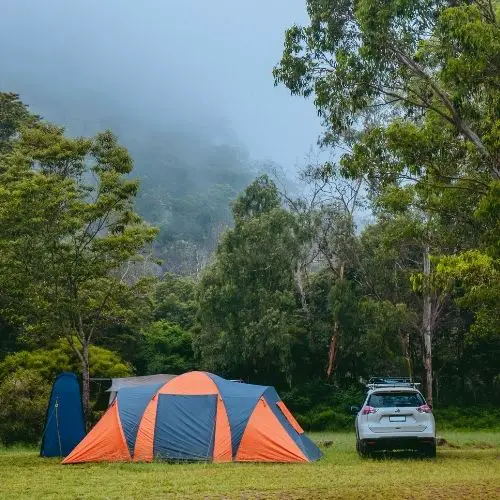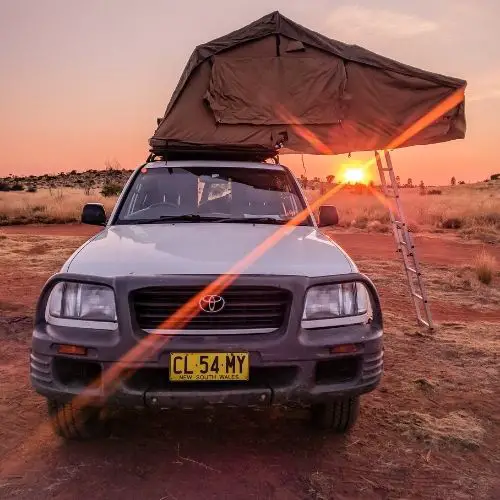We may get commissions for purchases made through links in this post. Thanks for the support! 👍
When it comes time to get out and see the world or immerse yourself in nature, there aren’t many wrong ways to do it. However, for some, there is a nomadic pulse that drives the adventurer to plan and discover ways to be mobile and self-sufficient.
In this case, we are talking about Car Camping and Overlanding. These nomadic travel styles allow folks to get out and experience new places while having a lot of what they need for a life packed right into their vehicle.
Hotels and resorts can be great, but there is a freedom that comes with being able to pack everything needed for your trip back into your car and drive off on the next adventure. But what exactly is Car-camping or Overlanding, and how do they differ?
Ultimately the main difference between car camping and overlanding come down to the capability of the vehicle you are using, and how long you plan on staying out there. These two things will determine what you will need to take with you, and determine what you are actually doing.
What is Car Camping?

If you have heard of camping, then you have heard of Car Camping. Car Camping is simply the act of driving up to a campsite, unpacking your car, and establishing a campsite outside of the vehicle.
The camp could be primitive, but it might also have maintained amenities like a fire-pit, bathrooms, and showers.
Upon arrival, one will typically unpack things like a cooler, a stove, some chairs, or a lantern and set up a camp for a couple of days. Usually, Car Campers are sleeping in a tent.
However, some people may choose to sleep in their car, especially if they have a larger vehicle or a truck with a camper shell.
This style of camping often happens over a weekend or a few days. Additionally, a car camping trip will usually consist of one destination where people show up, unpack, spend time, and then pack up and head home.
It can be a great way to relax and spend time hiking and exploring the area surrounding a campsite.
What is Overlanding?

Although similar to car camping, Overlanding has some important distinctions. With Car Camping, a campsite is set up outside of a parked car, but an Overlander’s car is the campsite.
Overlanders sleep inside their vehicles and typically have everything they need for travel inside or attached to their rig.
Overlanders have vans, recreational vehicles, or even old school buses that have been converted into more liveable spaces. Many people choose to build beds and include other amenities like small refrigerators, stoves, and even bathrooms.
Overlanding vehicles can be lived in without much setup and can even make camping on the side of the road a possibility.
Without the need for a dedicated campsite to unload all of their packed equipment, an Overlander has the freedom to make any legal parking spot their home for the night.
This freedom has lead to a slightly different style of travel. An Overlanding trip will often have multiple destinations, sometimes landing the traveler in a new spot each night.
Overlanders may pay for a campsite, but with so many free parking options, they can stay at rest stops, backcountry roads, and even Wal-Mart parking lots. There is a lot of freedom in Overlanding, and the trips will typically be longer, sometimes lasting months.
Should you car camp, or go overlanding?
While car camping and overlanding seem very similar, each one isn’t for everyone.
From what I have found, car camping is going to be best for those that don’t want to plan months ahead of time, as overlanding can take quite a bit of time to make the SUV or truck that you are working on capable enough to go off-roading, or be lived in for extended periods of time.
Overlanding also tends to be more expensive, due to the components you need to be purchasing to make your vehicle worthy of overlanding as well.
That said, overlanding will be a ton of fun, and be something you talk about for the rest of your life.
On the flip side, car camping doesn’t really take any vehicle modifications, and can be planned the week ahead of your adventure. You could even do it same day, if you plan on spending the night in the drivers or passenger seat of your car.
Car camping can also be done by people that have sports cars and sedans without an issue, as you can generally get by with minimal space when you are only going on an overnight adventure.
- Here What Yeti Drinkware Will Fit In Your Cup Holders
- Top 5 Essential Cooking Equipment For Camping
- Here’s Why Camping Is Better Than Hotels
Frequently Asked Questions
Why is overlanding so expensive?
Overlanding can be expensive due to the amount of equipment you likely will need. Common items like roof racks, roof tents, interior modifications to the vehicle, and an off-road capable truck or SUV can cost thousands of dollars to make happen.
What vehicles do you need for overlanding?
Generally overlanding will require a 4WD truck or SUV. This will be needed, as you will likely want to spend much of your time off-pavement and enjoying the great outdoors. However if you have the right vehicle, you can get away with 2WD or even a car.
What do you need for car camping?
Car camping is a simple type of camping, you will mainly need food and a change of clothes for the next day! If you plan on staying in your car for the night, you won’t even need a tent.
Conclusion
Practically, there is a lot of overlap between these two styles of travel.
You may see Car Campers traveling for months at a time, or you might see an Overlander getting away for a weekend with an excellent paid campsite. Both have their challenges, and each adventurer will have to discover what they are best equipped and suited for.
Regardless, both Car Camping and Overlanding are fantastic ways to explore with a sense of freedom and help put us on the road to experience more of what is out in the world.
![Can Camping Chairs Get Wet? [6 Examples]](https://amanandhisgear.com/wp-content/uploads/2020/10/Can-camping-chairs-get-wet_.jpg)

![You Need A Camping Journal [What Is It, And Why?]](https://amanandhisgear.com/wp-content/uploads/2020/10/Journal-and-notes.jpg)